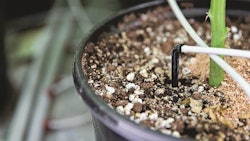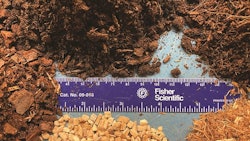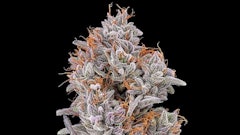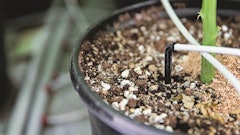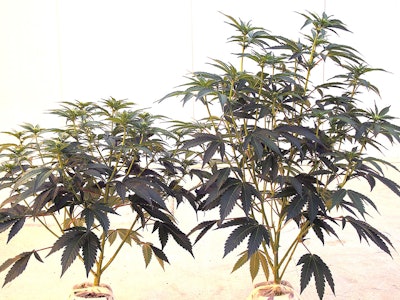
But there’s been an undercover assassin impacting this quality for decades now, refusing to show its face until it’s too late. This tiny, molecular parasite is highly infectious and responsible for billions of dollars in damage via reduced yields, underdeveloped trichomes and diminished THC content.
Hop latent viroid (HpLVd)—first reported in commercial varieties of hops in the late-1980s but only recently properly diagnosed in cannabis plants—stays busy producing millions of copies, and it uses the energy from the plant to do so. This is why infected cannabis plants experience stunted growth and don’t produce quality flower, said Dr. Zamir Punja, a professor of plant pathology and biotechnology at Simon Fraser University in British Columbia, Canada.

“There’s just no energy left to create cannabinoids,” he said, which is why many growers who first started noticing the symptoms of HpLVd’s unique RNA microbes in their plants often referred to the effects as “dudding” or “dudders.” Although, the symptoms aren’t always noticeable until the late stages of a cannabis plant’s life cycle.
“You’ve got smaller flowers, they may be a little bit yellow—they don’t look so good,” Punja said. “The rest of the plant may be a little stunted, but looks fine. You don’t see the leaves curling. So, it’s a weird one in that it knows the cannabis flowers are where to go and cause the most damage, and that’s where it ends up.”
Unless a cannabis cultivator is actively testing root samples from his or her plants, the viroid can be difficult to detect until the flowing stage of the growth cycle, when stunted growth and small bud sites become more evident. And because HpLVd is internalized, meaning it’s in the vascular system of the plant, any cuttings, particularly clones, will automatically have the viroid in them, Punja said.
The lack of external symptoms for HpLVd vastly differs from fungal diseases, such as the white or brown features associated with powdery mildew or botrytis, which cannabis cultivators can quickly identify and eradicate before infections become widespread throughout a grow.
The signs of HpLVd, however, are often unrecognizable to the untrained eye, especially considering various cannabis cultivars can develop different phenotypes that have diverse pigmentation or leaf sizes, making the viroid’s external symptoms less distinguishable, Punja said.
“And so, I call it a silent killer, because you don’t always see the symptoms,” he said. “It’s when you actually harvest the flowers and you weigh them that you realize, ‘Boy, this weight is down. What did I do wrong this year? Did I not fertilize properly? Was the environment too hot?’ And then when you measure THC, that’s down too.”
HpLVd’s impact on cannabis flower can be as much as 30% to 50% in reduced cannabinoid content, notably THC, Punja said. A cultivar that normally produces 25% THC when healthy could test as low as 15% to 18% THC, he said. Terpenes can be down by about 10%, but not all terpene compounds are affected. And while more research is needed, Punja said there are genotypic differences in the extent to which cannabinoid compounds are affected.
“I know [a cultivar] like Mac 1 is what we consider highly, highly sensitive,” he said. “And yet there might be another strain growing right next to it, let’s say a Kush variety, and it’s fine—or at least it’s not showing any symptoms. Now we have tested it, and we’ve found hop latent to be present, but it almost looks like the plant is sort of no big deal.”
Furthermore, Punja estimates hop latent viroid’s effect on reduced fresh flower weights to be in the range of 20% to 25%, although he discovered in his research that yields for certain cultivars could be impacted more or less. The following table shows differences among four genotypes and the average reductions in weight, THC content and growth.
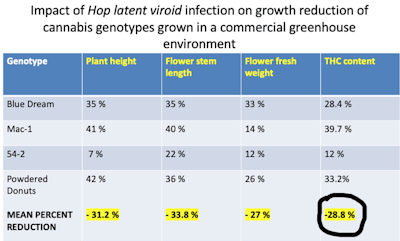
Regardless, the key is to know whether your plants are infected in order to prevent spread, Punja said. And this disease is not unique to one sector of the U.S. market or in Canada.
“It’s everywhere,” including in every province in Canada, he said. “The frequency is 25% of all plants we’ve tested [in Canada].” And Punja, who visits licensed cultivation facilities weekly, suggests the frequency rate is even higher in the U.S.
Notably, in early 2021, Dark Heart Nursey announced the findings of a formal survey of cannabis growers across California. The results: 90% of state facilities researched were testing positive for HpLVd after some 200,000 tissue tests.
So, what’s a cannabis cultivator to do?
Here, Punja goes into detail about four methods of spread for hop latent viroid in high-THC cannabis, and how to prevent the viroid from infecting healthy plants nearby.
Editor’s note: With more than 35 years’ experience in plant sciences, Dr. Zamir Punja’s research interests include the etiology and management of plant diseases on vegetables and horticultural crops, and the applicants of plant biotechnology for disease management. Since 2018, his work has shifted to researching cannabis, where his group has described a range of previously unreported pathogens affecting the crop and has evaluated various methods for disease management. He will be speaking at Cannabis Conference 2023 (Aug. 15-17 at the Paris Las Vegas Hotel and Casino) on “Cultivators’ Profit Killer: HpLVd And The Next Viruses Coming To Cannabis.”
1.) Infected Clones Taken From Infected Mother Plants
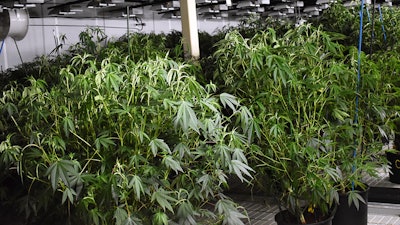
When a clone is taken from an infected mother plant, Punja said he’s observed 100% occurrence of hop latent viroid in the rooting of those clones during his research. This is the most likely source of spread, he said.
Some growers are only clipping the youngest shoots off the mother plants in an effort to try and stay ahead of the viroid, but that won’t eliminate the spread altogether, Punja said, even if the occurrence for transmission isn’t quite 100% while deploying this cloning method.
“I still think taking clones from an infected mom is dangerous because it’s already there; it’s internalized,” he said. “So, the minute you then start rooting it, you stick it into [stone wool], the first thing you see, of course, is there’s less roots. The rooting frequency is reduced.”
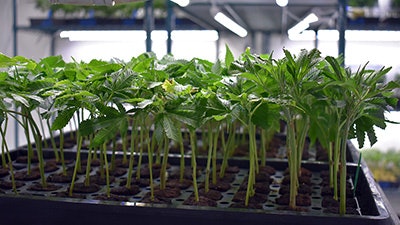
Sometimes adding the wrong amount of a rooting hormone, among other factors, can also affect the rooting system on clones. But if it takes 14 days for a decent rooting system to develop on healthy clones, and a grower notices that timeline extends to 21 days or more, then there’s a sign of a problem, Punja said.
Punja did stress that various genotypes do differ in their root development, so there’s not a one-size-fits-all timeline to this equation. But the roots are a great place to diagnose HpLVd.
During his research, Punja tested mother plants from four positions, taking samples from the top, the side, the bottom and the roots. On occasion, samples from certain sections, particularly leaves from the bottom section, of an infected mother plant tested negative for HpLVd. But the roots always tested correctly for the presence of the viroid, he said.
Similarly, Punja tested leaf samples, petiole samples and root samples of various genotypes, and the root samples consistently produced the most accurate results for the viroid while infected leaf samples—particularly those taken from the bottom of the plant—often produced false negatives.
“What we do know is when you test the roots, in every case, whether it’s showing symptoms, whether it’s a lower infection, whether it’s a high infection, the roots always seem to show a [correct] positive,” he said. “So, the first thing I think growers should do is have the [mother] plants tested and grab root a sample; run it through.”
2.) Seeds Harvested From Infected Flowering Plants

The second most likely source is from seeds harvested from infected flowering plants confirmed to contain the viroid, Punja said. This can occur at frequencies of 5% to 35%, depending on the level of initial infection in the flowering plant.
During his research, Punja collaborated with Colorado-based TUMI Genomics, which provides pathogen detection and mitigation solutions to safeguard plant health for the cannabis industry, including HpLVd testing.
With 18,000-plus diagnostics conducted for 450 customers from 10 countries, TUMI Genomics’ testing laboratory data has identified HpLVd in roughly 75% of facilities across the U.S., Canada and Europe.
Specifically as it relates to seeds, TUMI Genomics has conducted research in collaboration with the Agriculture Department at Texas A&M to determine the frequency of seed transmission for HpLVd in cannabis plants. The company shared its data with Punja.
“Even if the pollen is clean and you’ve got this infected mother [as the source for your seeds], many of those seeds, in some cases up to 30 to 40 percent, will carry the viroid either in it or on it,” he said. “Now, seed testing is hard. The reason I say that is because, well, once you ground up the seed, you don’t have anything left, right?”
Punja recommends that those who grow from seeds put their plants in a separate room all together, let them grow to 1 1/2 or 2 feet, and then test the roots right away before bringing those plants into a production facility.
Some growers will try and disinfect their seeds before germination. Often, they will use a 10% bleach concentration for two minutes in an effort to disinfect without killing the seed, Punja said.
“That seems to be OK for eliminating some of [the viroid] on the outside and still allowing you to grow and germinate your seed,” he said. “If it’s in the seed, the only way to know that would be then to grow those plants up and then maybe take random samples when they’re up at a certain height and test the roots.”
3.) The Viroid Spreads Through Infected Sap on Contaminated Tools
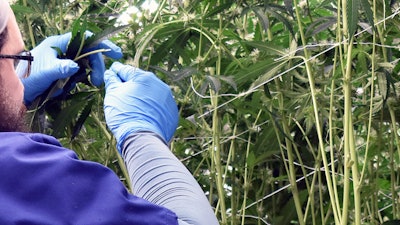
The third likely source of hop latent viroid spread is through infected sap on contaminated tools used to prune plants or obtain cuts for clones, Punja said.
In this method, the viroid spread occurs from the cut stem (an open wound) down into the roots within two weeks, and then it spreads from the roots through the rest of the plant in four to six weeks, he said.
“That’s where dipping your tools into bleach or Virkon becomes really important, because if you do cut an infected mom not knowing and immediately use those scissors to cut another mom, [the viroid spreads],” Punja said “We’ve demonstrated that [getting] that little bit of sap onto the fresh plant will move the viroid into the plant.”
While most growers already know disinfecting their tools is key to preventing disease spread, Punja said it’s important to note that ethanol and hydrogen peroxide don’t seem to be effective for HpLVd prevention. The maximum infection rate is roughly 25% for any cuts, prunes or damaged surface that allows HpLVd to get in, he said.
But Punja does not believe simply touching or gentling handling one plant and then another is a cause for spread. While infected sap can survive on nitrile disposable gloves, the ones often used at cultivation facilities, defoliating a canopy by hand does not present a high risk for spreading the viroid, he said.
While pruning involves using shearers to snip branches and stems, defoliation involves the hand-plucking of fan leaves to allow air circulation and light penetration throughout a canopy.
WATCH: How to Defoliate a Canopy
“They go through it, and they pull the leaves off, and they don’t go back and retouch the [same area of the] plant. So I don’t think that’s a major way for it to spread,” Punja said. “It’s also pretty clear that the earlier the infection, the more chances you’re going to get problems later on. So, the earliest you can get infection obviously is the clone.”
Defoliation usually occurs right before the flowering stage and again shortly after. Once the plant leaves the nursery and then gets into the flowering room, if hop latent viroid infection occurs there, the impacts aren’t as severe because the viroid has less time to spread, he said.
4.) Infected Roots in a Hydropic System, Root-to-Root Contact, or Recirculating Nutrient Solution Containing the Viroid

While there is no scientific evidence (yet) of HpLVd spreading simply by plant leaves touching each another, root-to-root contact or fertigation/irrigation methods involving recirculating water or nutrient solutions is a fourth source of spread.
And, as Punja mentioned earlier, the roots are the most reliable part of the plant to test for the presence of the viroid.
“Hydroponic systems are more vulnerable to hop latent, because if they’re sitting in [stone wool] and they’re on a flood table, the roots are coming through,” he said. “If that plant has hop latent, it gets into the root first. And root cells come off; they slough off just like skin. And those cells, if they move down the table or if they move with irrigation water, or if the grower is recirculating and recycling water, which they should be doing, there’s a good chance that water’s contaminated and it’s got some hop latent in it and it moves over to another plant.”
The occurrence rate isn’t as significant in this method of spread—Punja said roughly 20% infection can occur in the roots through water circulation—but root debris and cellular transmission of the viroid is a big enough concern for growers to pay attention to, he said.
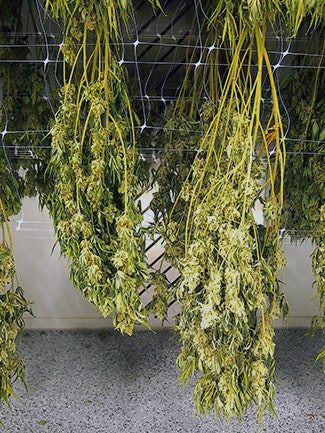
While management practices should target the most likely methods of HpLVd spread—such as maintaining viroid-free mother plants, testing clones and seeds, and properly cleaning tools—mitigating the spread in hydroponic systems isn’t so easy, especially considering the viroid remains stable up to 175 degrees Fahrenheit (80 degrees Celsius), Punja said.
For recirculated/recycled water, treatments can include heat or adding chemicals such as hypochlorous acid (to produce chlorine), as well as other disinfectants, he said. Punja does not have data on this yet, as treating water that has viroid in it and then showing it is absent or noninfective is difficult experimentally, he said.
“The interesting thing is soil,” he said. “A lot of soil growers say, ‘We don’t see a lot of hop latent.’ Now that may be that they got lucky or they haven’t seen the symptoms, but in soil it rules out that 20% infection through water. It just doesn’t happen. Water’s going to percolate through the soil; it’s not going to make it to the root system, and you’re not going to see root-to-root spread.”
Soil-grown cannabis may have less of an incidence for spread, but fewer indoor or greenhouse growers are using soil because of the associated costs compared to using stone wool.
“The latest thing I’m looking at is treatment,” Punja said, “What can we do to see if we can eliminate, or at least prevent, the spread of this thing? It’s going to be tough because in every other case where they’ve had viroids, let’s say potato or tomato, they’ve gotten rid of it simply by throwing everything infected out and starting clean and keeping it clean.”
With many cannabis cultivators hoarding their coveted genetics for decades, the idea of “throwing everything infected” away isn’t an idea received with open arms among legacy operators. While flower quality is everything, so too are genetics.
Instead of full eradication, many growers are dedicated to “breeding down” their genetics to imperceptible levels.
But is this a viable option?
“I think it’s definitely possible,” Punja said. “But the key is to know that you have infection. You can’t just breed, breed, breed and say, ‘Oh, it looks great.’… It reminds me of COVID, how some people get really bad symptoms and others are fine. That’s exactly the case [with HpLVd in cannabis plants]. You may have certain genetics that just collapse and another one that is able to withstand it.
“So, that’s sort of the symptomology that maybe it’s environment, maybe it’s genetic—we don’t know yet. But the short answer is, yes, go for the breeding.”









